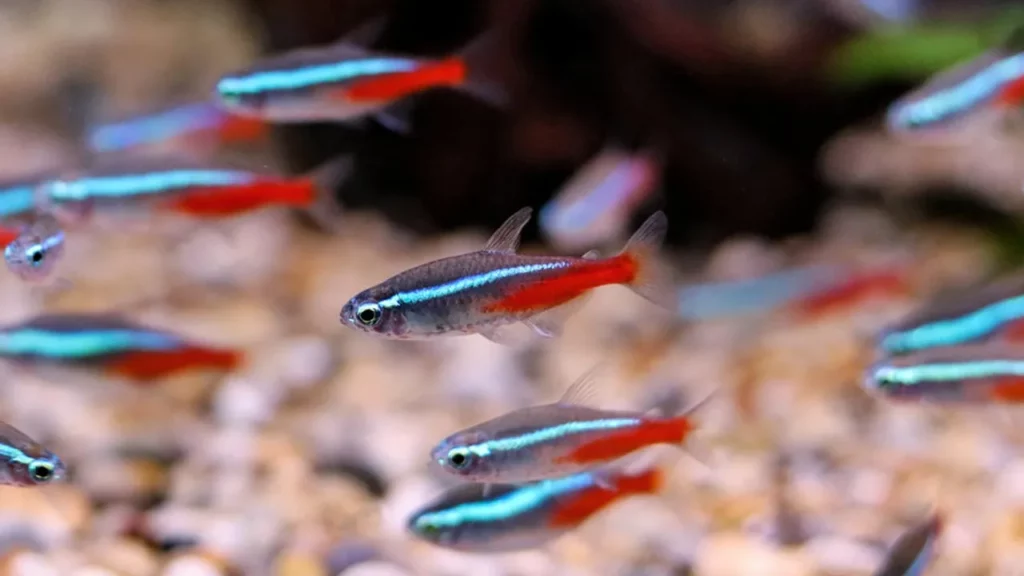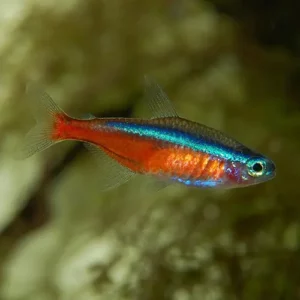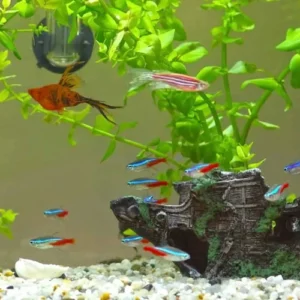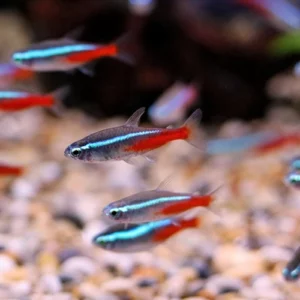Are Neon Tetras A Schooling Fish?
Neon tetras are indeed schooling fish. Schooling is a behavior where fish swim in a coordinated manner, often in the same direction, which differs from shoaling where fish simply congregate. Neon tetras school for various reasons including evolutionary, defensive, and social purposes. In the wild, they display this behavior to navigate the vast Amazonian habitats, benefiting from safety in numbers, enhanced foraging, and improved mating opportunities. In aquarium settings, they maintain group dynamics, and it’s recommended to have at least 6-10 neon tetras for proper schooling behavior.
Home » Guides » Fish Care » Neon Tetra » Are Neon Tetras A Schooling Fish?
Neon Tetra Fact Sheet
| Scientific Name | Paracheirodon innesi |
| Common Name | Neon Tetra, Neons |
| Care Difficulty | Easy |
| Life Expectancy | 3-10 Years |
| Average Size | 1.5 Inches (3.8cm) |
| Temperature | 72°F – 82°F (22°C -28°C) |
| Diet | Omnivore |
| Behavior | Friendly/Peaceful |
| Breeding | Medium/Hard |
| pH | 6-7.5 |
| Live Plant Friendly | Yes |
Defining Schooling Behavior in Fish
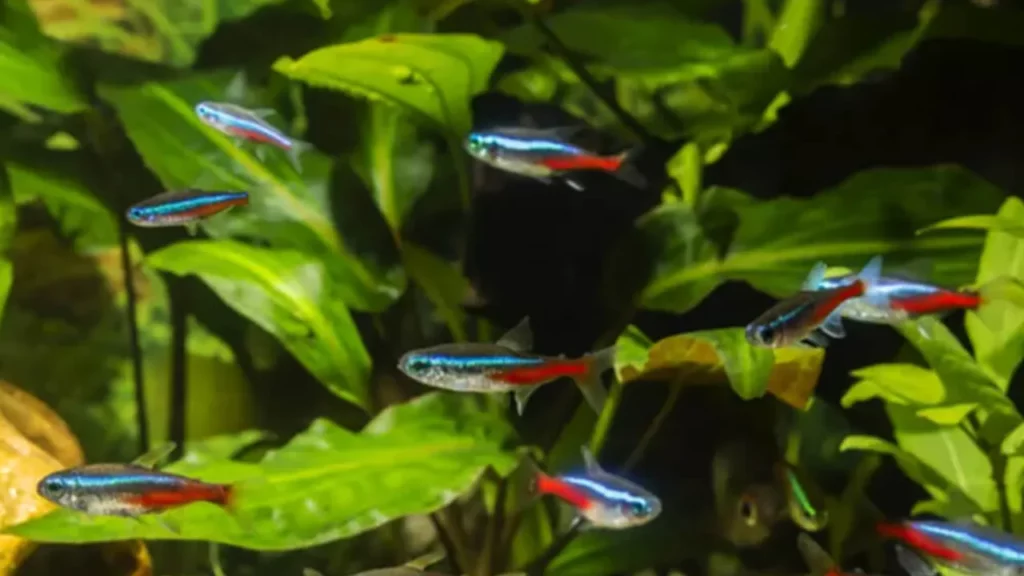
What is Schooling?
What is Schooling?
First and foremost, when you look at a group of fish moving in unison, painting a moving mosaic beneath the water’s surface, you might think, “Oh, look at those fish schooling together!” And you’d be half right. While we commonly use the term ‘schooling’ for any group of fish, there’s a slight nuance you’ll want to understand.
Schooling is when fish swim in a coordinated manner, moving in the same direction. It’s a sight to behold – almost like a ballet underwater, where each fish knows its place and follows a precise choreography. Each fish maintains a particular distance and angle from its neighbors, creating an awe-inspiring synchronized movement. It’s nature’s orchestra with not a single maestro in sight!
On the other hand, there’s shoaling. Shoaling refers to fish that group together, but they don’t necessarily swim in unison or the same direction. They’re more like a gathering of friends at a café, each doing their own thing but enjoying each other’s company.
So, to sum it up: All schooling fish shoal, but not all shoaling fish school. Sounds a bit like a riddle, doesn’t it? But it’s this delicate distinction that makes observing aquatic life such a delight.
Fish might shoal for various reasons – social interaction, mating, or even just for the sheer joy of it (because who doesn’t love a good underwater get-together?). But when they school, it’s often for more specific reasons which we’ll delve into next.
Reasons Fish School
Reasons Fish School
Evolutionary Reasons: Nature, in its grand design, often encourages survival of the fittest. And for many fish, schooling is an evolutionary gift. Swimming together in large, synchronized groups makes it hard for predators to single out and target an individual. It’s a bit like watching a whirlwind of colors and shapes; it’s mesmerizing but challenging to focus on just one element. Over time, those who stayed close and schooled were more likely to survive and pass on their genes. Thus, the choreography of life was set in motion!
Defensive Mechanisms: Aside from the confusing visual spectacle a school presents, there’s also safety in numbers. Imagine you’re a hungry predator and suddenly you’re faced with hundreds, if not thousands, of potential meals darting around. Where do you begin? By the time you’ve decided, the school has shifted and reformed, making it quite the task to nab a snack. Some fish even use schooling to create the illusion of a much larger organism, deterring would-be attackers.
Social Reasons: Fish, believe it or not, can be quite the social creatures! Schooling provides a platform for them to interact, communicate, and even mate. It’s the underwater equivalent of a bustling town square. Within the intricacies of these formations, fish exchange information about food locations, predators, or potential mates. It’s like an aquatic social media network, without the smartphones!
Efficiency in Movement: Here’s an interesting tidbit – moving together can be energy efficient! Fish in the front pave the way, creating slipstreams that those behind can glide into, saving energy. It’s like cyclists in a peloton, where riders take turns leading and then fall back to conserve strength. Who would’ve thought our finned friends were so strategic?
Neon Tetras: An Iconic Schooling Species
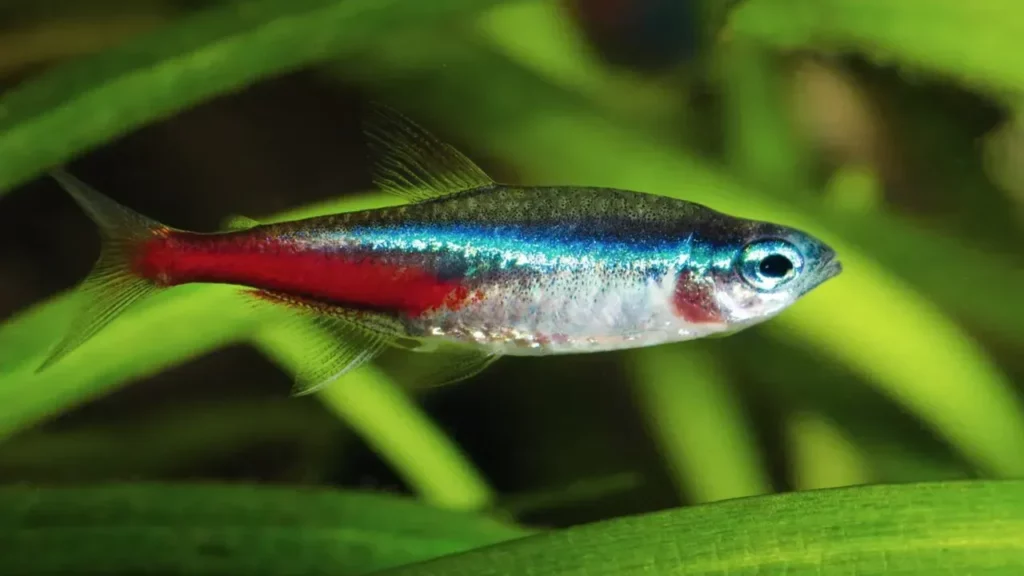
Observations in the Wild
Observations in the Wild
Natural Habitat: Neon tetras hail from the clear freshwater streams and rivers of South America, specifically the Amazon basin. It’s a world bursting with life, where sunrays pierce through dense canopies, creating dappled light shows beneath the water’s surface. In these dimly lit, slightly acidic waters, the neon tetra’s brilliant blue and red stripes glow almost magically, like nature’s very own neon signs.
Behavior in the Wild: When observing these beauties in their natural habitats, one thing becomes abundantly clear: they are true schooling fish. Neon tetras move together like a synchronized cloud, reflecting flashes of color as they navigate through aquatic plants and submerged roots. They remain close to each other, using their numbers not just for protection, but also for finding food. As insect larvae and tiny crustaceans float by, the school breaks formation momentarily to feast, only to reform again swiftly.
Adaptation to Dim Light: Their iridescent color isn’t just for show. In the shaded Amazonian waters, their unique bioluminescence becomes both a beacon for fellow tetras and a means of communication. Quick flashes or changes in their brightness often indicate alerts for predators or signals for mating rituals.
Interaction with Other Species: The Amazon is teeming with a myriad of aquatic species. And while neon tetras are small, measuring just about 3 cm in adulthood, their schooling behavior ensures they remain quite visible. This visibility often deters potential predators. However, when a threat is sensed, like the approaching shadow of a larger fish, the school disperses in a burst of color, only to regroup once the danger has passed.
Benefits of Schooling for Neon Tetras
Benefits of Schooling for Neon Tetras
Safety in Numbers: Ah, the classic defense mechanism of the underwater world. For neon tetras, their radiant glow, while beautiful, can also make them a tantalizing target for predators. By schooling, they create a shimmering, shifting tapestry that’s hard for predators to focus on. Picture it: a predator lunges at what seems like an easy target, only to find itself snapping at empty water as the school elegantly shifts away in unison. It’s a sight as baffling for the predator as it is mesmerizing for us observers!
Enhanced Foraging: Food! A necessity for all living beings and the neon tetras are no exception. In the vast expanse of the Amazon, food sources like tiny crustaceans, insect larvae, or even microscopic algae can be sporadic. When neon tetras school, they collectively cover more ground (or should I say water?) increasing their chances of locating food. Once a food source is found, the synchronized school transforms into a flurry of feeding frenzy, ensuring most get a bite of the bounty.
Improved Mating Opportunities: The dance of love is intricate in the aquatic realm. For neon tetras, schooling provides ample opportunities for males to court females. Within the coordinated ballet of the school, males often display enhanced colors and particular swimming patterns to woo potential mates. The females, in response, can choose from a selection of suitors, ensuring the continuation of their brilliantly luminescent lineage.
Social Interaction: Beyond the practicalities of survival and procreation, neon tetras, like many of us, enjoy the simple pleasure of companionship. Schooling provides a constant environment for social interactions, be it playful chases, synchronized swimming, or just basking in the collective glow of the group.
Schooling Behavior in Aquarium Settings
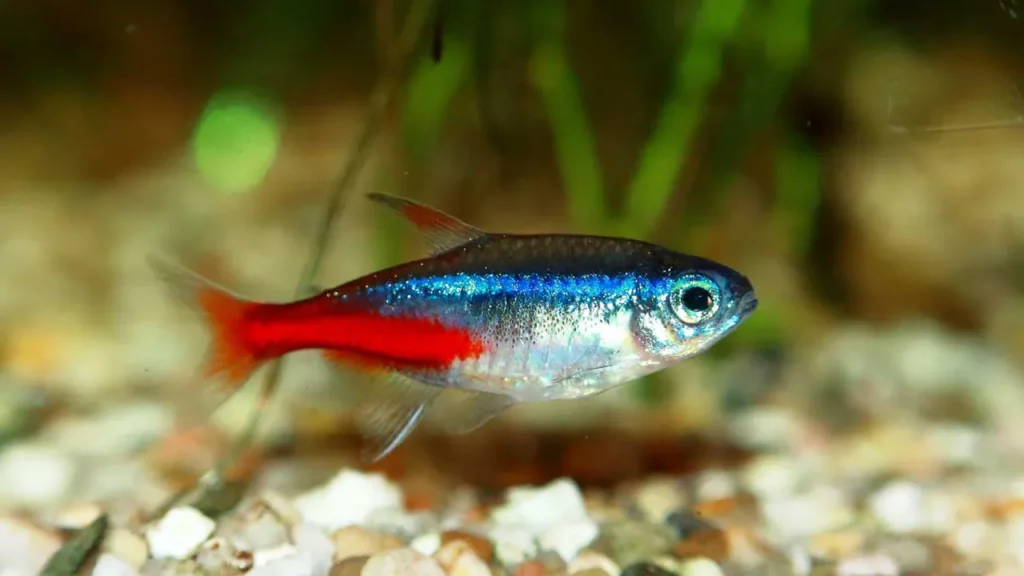
Group Dynamics
Group Dynamics
Close Quarters, Closer Bonds:
In the vastness of the Amazon, neon tetras have the luxury of space. But in an aquarium, these boundaries are limited. However, the confinement does not dampen their spirit! Neon tetras stick even closer together, emphasizing their natural schooling behavior. It’s akin to a tight-knit family, leaning on each other a little more when the world around them gets a bit smaller.
Leaders and Followers:
Observing neon tetras in aquariums, you might notice that certain individuals tend to lead the group more often, while others follow. This subtle hierarchy, with dominant tetras taking the lead, is a fascinating spectacle. Leaders often change, providing a dynamic shift in the group’s movements and directions. It’s a fluid dance of power and harmony.
Interactions with Other Species:
Many aquarium enthusiasts introduce various species into their tanks, and this can influence neon tetra behavior. While they generally maintain their close-knit schooling, they can become more cautious around larger or more aggressive fish. On the flip side, when housed with passive species, neon tetras often exhibit bolder behaviors, venturing out and interacting more openly.
Recreating Amazonian Comfort:
A well-thought-out aquarium, lush with aquatic plants and hiding spots, can see neon tetras displaying behaviors akin to their wild counterparts. They weave in and out of plant leaves, hover around gentle currents from filters (mimicking river streams), and even engage in playful chases. It’s a testament to their adaptability and the importance of recreating natural-like conditions in captivity.
Minimum Numbers for a School
Minimum Numbers for a School
The Magic Number:
While you might spot the odd neon tetra swimming solo during moments of exploration or feeding, they truly thrive when in a group. A common recommendation for starting a school of neon tetras in captivity is a group of at least 6. This provides them with a sense of security and allows them to display their natural schooling behaviors.
More is Merrier (Most Times):
In the wild, neon tetras can be found in schools of hundreds, even thousands. So, while six is a good starting point, increasing this number can lead to even more harmonious behaviors. In a well-maintained aquarium with ample space, a group of 10-15 neon tetras can lead to a mesmerizing display of synchronized swimming and interactions.
Tank Size Matters:
Before you dive into creating a colossal school, always consider the size of your aquarium. Neon tetras, while small, still need space to swim, explore, and express natural behaviors. A general guideline is to have at least 1-2 gallons of water per neon tetra. So, for a school of 10, a tank size of 20 gallons or more would be ideal.
Balance and Biodiversity:
Having other species in your aquarium? It’s crucial to ensure that there’s a harmonious balance. While neon tetras are peaceable by nature, an overcrowded tank can lead to stress, territorial disputes, and health issues. Moreover, ensure that the tank mates are compatible in terms of temperament and water requirements.
Impact on Fish Well-being
Impact on Fish Well-being
The Stress Factor:
Fish, despite their serene facade, can experience stress, much like any other creature. For neon tetras, the security of a school acts as a buffer against the daily stresses of aquatic life. Isolated or in insufficient numbers, these glimmering gems can become more susceptible to stress, manifesting as erratic swimming patterns, faded colors, or a loss of appetite.
Physical Health:
The adage ‘strength in numbers’ holds especially true in the fishy world. A proper school size not only ensures mental well-being but also has direct implications for physical health. Fish in a stressed state can have compromised immune systems, making them more vulnerable to diseases and infections. A robust school can counteract these negatives, providing a secure environment where neon tetras can flourish and shine at their healthiest.
Behavioral Enrichment:
Imagine a life where every day is a repeat of the last, with no interaction or stimulation. It’d be dull, wouldn’t it? The same goes for our neon tetras. A thriving school offers them a dynamic environment. They can engage in social interactions, chase one another playfully, and partake in the mesmerizing dance of synchronized swimming. This behavioral enrichment is vital for their mental stimulation and overall happiness.
Life Span and Reproductive Success:
Schooling doesn’t just impact the immediate well-being of neon tetras. Over time, fish that experience less stress, have consistent social interactions, and live in a stimulating environment tend to have longer lifespans. Moreover, a cohesive school offers better opportunities for mating rituals and successful reproduction, ensuring the next generation of neon tetras is just as vibrant and healthy.
Signs of a Comfortable School
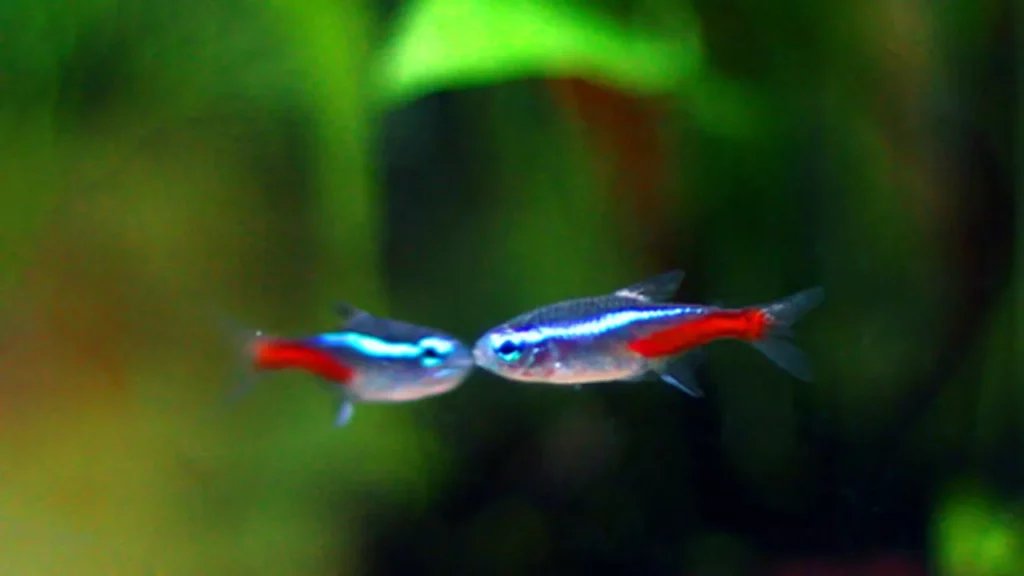
Synchronized Swimming
Synchronized Swimming
A Dance of Unity:
Have you ever paused at an aquarium and watched, transfixed, as a school of neon tetras moved as one cohesive unit, turning, diving, and rising in flawless harmony? This isn’t just a random act. It’s an innate behavior called synchronized swimming. Just like dancers on a stage, each fish is acutely aware of its neighbors, adjusting its movements to match the rhythm of the group.
The Art of Communication:
So, how do they manage this impressive feat? Well, fish have specialized cells called ‘lateral line systems’ that detect minute changes in water pressure. This allows them to sense the movements of their fellow fish and adjust accordingly. It’s a silent, underwater dialogue that ensures the school moves as a unified entity.
Benefits Beyond Beauty:
While the synchronized dance of neon tetras is a visual delight for observers, it serves a deeper purpose. Moving in perfect harmony makes it difficult for predators to single out and target an individual fish. The shimmering, coordinated display can confuse and deter potential threats. Safety, it seems, truly lies in unity.
Reflection of Health:
A school’s ability to swim in sync also acts as a barometer of their well-being. Healthy, stress-free neon tetras are more likely to exhibit strong synchronized behaviors. Conversely, a school that seems disjointed or erratic might be signaling underlying issues, be it environmental stress, illness, or other disturbances.
Reduced Stress Indicators
Reduced Stress Indicators
Bright and Shimmering Colors:
One of the most immediate signs of a contented neon tetra is its radiant coloration. When in good health and low-stress conditions, these little swimmers shine brilliantly with their iconic neon stripe. If they’re stressed or unwell, this color can fade or appear muted. So, a vibrant neon tetra is not just a feast for the eyes but also a reassuring sign of their well-being.
Consistent and Relaxed Swimming Patterns:
Neon tetras, when comfortable, exhibit graceful and consistent swimming behaviors. They aren’t darting around the tank erratically or hiding constantly. Instead, you’ll find them smoothly navigating their environment, individually and as a part of their school, exploring every nook and cranny with assured curiosity.
Healthy Appetite:
Like many creatures (humans included), food plays a vital role in indicating the comfort level of neon tetras. A stress-free neon tetra will have a consistent appetite, approaching feeding times with enthusiasm. On the other hand, sudden loss of appetite or indifference to food often hints at underlying stress or health issues.
Engagement with Fellow Tetras:
In a harmonious environment, neon tetras will engage with their schoolmates actively. You’ll witness them playing, chasing one another in friendly bouts, or simply swimming side by side. Reduced interaction or isolation from the group can be a sign of stress or discomfort.
Absence of Stress-Induced Behaviors:
Certain behaviors, such as rapid gill movement, skittishness, glass surfing (swimming up and down the tank sides), or prolonged hiding, are often indicative of stress. A content and comfortable neon tetra will seldom exhibit these signs.
Active Exploration
Active Exploration
The Heart of an Explorer:
Much like us, neon tetras are innately curious creatures. Given the right environment, these luminous beings will venture out, inspecting every crevice, plant leaf, and ornament with a blend of caution and enthusiasm. It’s akin to watching a child discover a new playground, each corner holding a new wonder.
Significance of Exploration:
Active exploration is not merely a pastime for these little swimmers. It’s a positive behavioral trait indicating contentment, security, and well-being. A neon tetra that feels safe and comfortable in its environment will be more inclined to explore. It’s a testament to their health, both physical and mental.
Encouraging Curiosity:
Want to spark the spirit of adventure in your neon tetras? Introducing a variety of plants, different textured substrates, and safe aquarium decorations can make their environment more engaging. Ensure, however, that any additions are safe and free from sharp edges or toxic materials.
Balancing Act:
While exploration is vital, it’s equally essential for neon tetras to have hiding spots. Places like dense plant thickets or cave-like ornaments offer them refuge if they feel threatened. It’s all about striking the right balance between open spaces for exploration and sheltered spots for rest.
Indicator of Comfort:
A neon tetra that’s frequently hiding or sticking to one corner might be signaling discomfort or stress. A confident, exploring tetra, on the other hand, indicates a well-adjusted fish thriving in its environment. Observing their exploratory behaviors can give aquarists valuable insights into their comfort levels and overall well-being.
Potential Issues in Underpopulated Tanks

Stress and Fear Behaviors
Stress and Fear Behaviors
The Language of Stress:
Just as joy and contentment have their dialects in the world of fish, so too do stress and fear. For neon tetras, these behaviors can be quite pronounced, turning our shimmering friends into shadows of their vibrant selves.
Erratic Movements:
One of the first signs you might notice is erratic swimming. Instead of their usual graceful dance, stressed neon tetras might dart around the tank abruptly, an obvious departure from their regular, synchronized maneuvers.
Color Fading:
A neon tetra in distress might lose the very trait that gives it its name: its brilliant neon coloration. This dimming can be particularly pronounced in the blue-green stripe that adorns its body, turning it into a pale, almost ghostly hue.
Glass Surfing:
If your tetra spends an inordinate amount of time swimming vertically along the tank’s glass, it might be exhibiting a behavior known as ‘glass surfing’. This could indicate stress, discomfort, or even a reflection of a sub-optimal environment.
Hiding Constantly:
While it’s natural for neon tetras to seek shelter occasionally, prolonged periods of hiding can be a cry for help. A tetra that’s constantly buried in the tank’s nooks and crannies might be signaling that it feels threatened or unwell.
Decreased Social Interaction:
Neon tetras are social creatures, thriving in the company of their kind. When stress or fear strikes, this social tendency can be disrupted, leading to decreased interaction with their schoolmates.
Understanding the Causes:
Identifying stress behaviors is just the tip of the iceberg; it’s equally important to understand their root causes. Factors can range from poor water quality, inappropriate tank mates, inadequate diet, or even too bright lighting.
Increased Susceptibility to Diseases
Increased Susceptibility to Diseases
The Delicate Balance:
Life, whether under the sea or on terra firma, is a delicate balance of countless factors. Just as stress and anxiety can compromise human immunity, stress in neon tetras can weaken their natural defenses, making them more susceptible to various illnesses.
Understanding the Immune System:
Neon tetras, like all fish, possess an immune system designed to ward off potential pathogens. Under normal circumstances, they’re quite adept at keeping disease at bay. However, when subjected to prolonged stress – be it from environmental factors, social dynamics, or other triggers – this defense mechanism can become compromised.
Common Illnesses:
Stressed neon tetras may fall prey to a range of diseases, including:
- Ichthyophthirius multifiliis, commonly known as ‘Ich’ or white spot disease. This ailment manifests as tiny white spots on the fish’s skin and gills.
- Fungal infections, which appear as cottony growths on the fish’s body.
- Parasitic infections like Hexamita, causing issues like hole-in-the-head disease.
Preventative Care is Key:
The best way to shield neon tetras from diseases is to prevent stress in the first place. Regularly monitoring water parameters, ensuring a well-balanced diet, providing ample hiding spots, and avoiding overcrowded tanks are just a few ways to keep stress at bay.
Observation and Action:
Should you observe signs of illness, it’s vital to act promptly. Quarantine affected fish, seek expert advice, and consider treatments suitable for the specific ailment. It’s always preferable to consult with an aquatic veterinarian or experienced aquarist to ensure you’re taking the right steps.
Reduced Lifespan
Reduced Lifespan
The Ephemeral Nature of Life:
All life forms, no matter how small or expansive, are ephemeral, like the fleeting flash of a neon tetra’s shimmer. However, when their natural lifespan is cut short due to avoidable reasons, it compels us to introspect and amend our care practices.
Stress: The Silent Lifespan Shortener:
Chronic stress is a well-documented factor in reducing the lifespan of many organisms, neon tetras included. Continual stress doesn’t just increase susceptibility to diseases, as previously discussed, but can directly impact the longevity of our fishy friends.
Balancing Act:
An aquarium, at its core, is an artfully designed microcosm. Striking a balance between water quality, dietary needs, lighting conditions, and social interactions is vital. Even slight deviations can cumulatively contribute to reducing the overall lifespan of neon tetras.
Age is More Than Just a Number:
While neon tetras generally live for about 5 to 10 years in well-maintained conditions, their quality of life during this time frame is paramount. A tetra living for a shorter period in a stress-free environment can have a fuller life than one enduring constant stress for a marginally longer time.
Our Role as Custodians:
As stewards of these marine marvels, it’s our responsibility to not only aim for longevity but also to ensure each moment they swim under our care is filled with comfort and vitality. This involves regular water testing, providing a balanced diet, ensuring appropriate social interactions, and more.
Frequently Asked Questions – FAQ
Give Us Feedback
Please help us get better by making suggestions or giving feedback, we really do listen to it!
